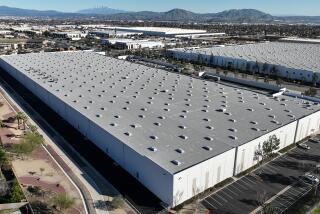Panel Reaches Compromise on Bid for Collider
- Share via
SACRAMENTO — An Assembly-Senate negotiating committee reached agreement Tuesday on controversial affirmative action goals to be contained in the state’s bid to make California the home of the world’s largest atom smasher.
The agreement, which still faces an uncertain future in the Assembly and Senate, was reached on the eve of today’s 11 a.m. deadline set by the U.S. Department of Energy for the submission of states’ bids.
The six-member conference committee, with four Democrats and two Republicans, approved the legislation unanimously.
Simply put, the compromise would tie the affirmative action goals to those being achieved on state highway construction projects. From the federal government’s standpoint, the central feature of the bid would be the promise of a $560-million state bond issue to finance purchase of land and site improvements for the $4.4-billion project.
The Department of Energy, responsible for siting the proposed atom smasher, called the superconducting super collider, has warned that today’s deadline is firm and that no extensions will be made.
Supporters of the legislation hoped to bring the measure up for a quick vote Tuesday night, but said they expected a strenuous fight in the Assembly. Republicans had been blocking the legislation because of their opposition to affirmative action goals demanded by Democrats.
With 3,000 permanent jobs and as many as 25,000 temporary construction jobs going to the winning applicant, however, the GOP lawmaker who offered the compromise that broke the negotiating committee’s deadlock said a desire to win an economic bonanza for the state overrode philosophical considerations.
Even so, Assemblyman William P. Baker (R-Danville) said, many GOP lawmakers oppose the legislation.
“The Republican Caucus is strongly against (affirmative action) goals, quotas, set-asides. We don’t think it is good public policy,” Baker said, adding, “The bid should go to the lowest bidder qualified to do the work.”
Baker, whose proposed amendments were quickly approved by four Democrats sitting on the committee, said Republicans yielded to Democratic pressure only because of “our desire to allow this state to compete for the super collider project.”
While California lawmakers were fighting over affirmative action goals in Sacramento, other states were putting the finishing touches on their bids and submitting them to the Department of Energy in Washington.
At least 30 proposals are being made by other states. Illinois, New York, Texas and other states are in intense competition for the project.
2 Proposed Sites
California’s bid proposal is contained in two nine-volume sets. It is offering two sites: one near Davis, just west of Sacramento, and the other east of Stockton.
Under the legislation approved by the conference committee, authored by Assemblyman Sam Farr (D-Carmel), California would agree to float a $560-million bond issue to buy land and make sewer, highway and other site improvements necessary for the project.
Similar proposals, characterized by huge quantities of paper as well as big dollars, are being made by other states.
The bid offered by Texas weighed in at 2,400 pounds and contains inducements valued at $700 million. The Illinois proposal totaled 600 pages. Ohio packaged its bid in 60 boxes.
The Department of Energy will ask the National Academy of Sciences to evaluate each bid. After the evaluations, a short list of finalists will be announced in December. The winner will probably be selected next summer.
The super collider, as envisioned by the Deparment of Energy, will be constructed at least 50 feet underground. It will be a tunnel 53 miles in diameter, shaped like a race track. When completed, it will be the world’s largest scientific instrument. It will use 10,000 magnets to propel protons in opposite directions at near the speed of light to create collisions.
Scientists hope that the experiments in high-energy physics that will be made possible by the collider will give them answers about the basic structure of matter and the origins of the universe.
In the negotiations over the California proposal, opposition to the legislation centered on demands by Assembly Democrats that firms owned by women and minorities be given part of the bond and construction business spawned by the project.
At first, Democrats asked for affirmative action goals that would steer 20% of the business to firms owned by minorities and 20% to companies owned by women.
Because of fierce opposition from Republicans, Democrats retreated, dropping their demands to goals of 15% to minority businesses and 5% to firms owned by women.
The compromise reached Tuesday will reduce the levels even further, although precise numbers were not available. Estimates were that the total amount of business steered to companies owned by women and minorities would be between 12% and 16%.
The compromise offered by Baker would tie the affirmative action goals to the experience of the state Department of Transportation in awarding highway construction contracts to firms owned by minorities and women.
In 1984 and 1985, according to a recent report by Caltrans, 15.8% of highway business was being steered to minority companies and 3.2% to firms owned by women.
‘Skewed’ Figures
Republican amendments to the collider legislation specifically bar inclusion of minority figures stemming from the Century Freeway project in Los Angeles because Baker said they were “skewed” toward minorities.
Gov. George Deukmejian generally has stayed out of the legislative fight, although he has urged both sides to reach a compromise and pass the collider legislation.
During his weekly radio speech last Saturday, Deukmejian urged the Legislature to act.
“In addition to the scientific advances that would result from the project, the collider is also expected to generate billions of dollars in new business activity, hundreds of millions of dollars in additional tax revenues and thousands of new jobs for the state in which it is located,” he said.
In a plea to lawmakers, he said: “Don’t pull California off the field before the game even begins.”
Although the primary objective is to win the collider project, some state officials believe that California must make a strong bid to erase a series of lackluster efforts that have seen other states win one high-technology project after another.
Particularly embarrassing was the loss of a national earthquake research center to New York last year. North Carolina and Texas also outbid California for high-tech research projects.
More to Read
Get the L.A. Times Politics newsletter
Deeply reported insights into legislation, politics and policy from Sacramento, Washington and beyond. In your inbox twice per week.
You may occasionally receive promotional content from the Los Angeles Times.










